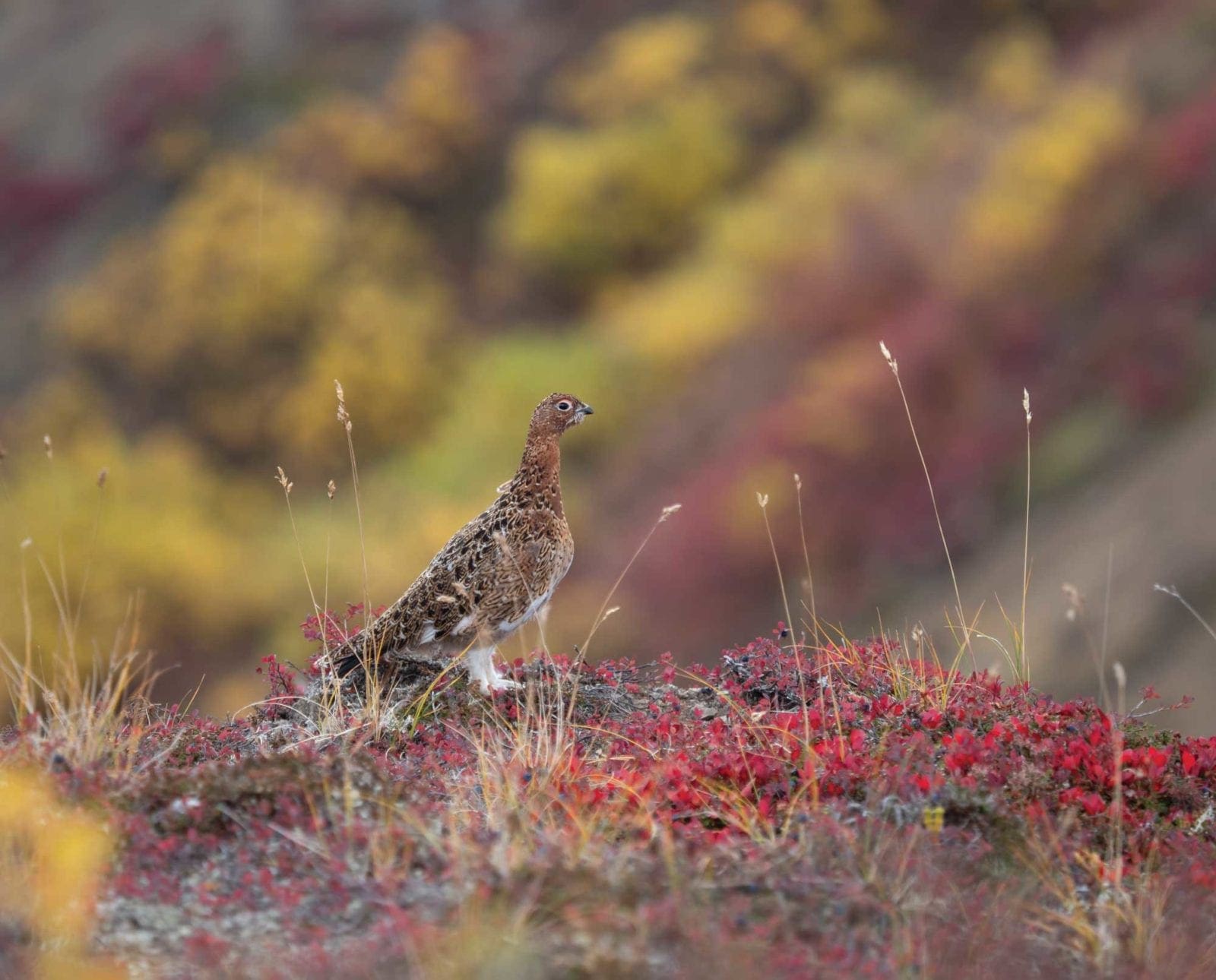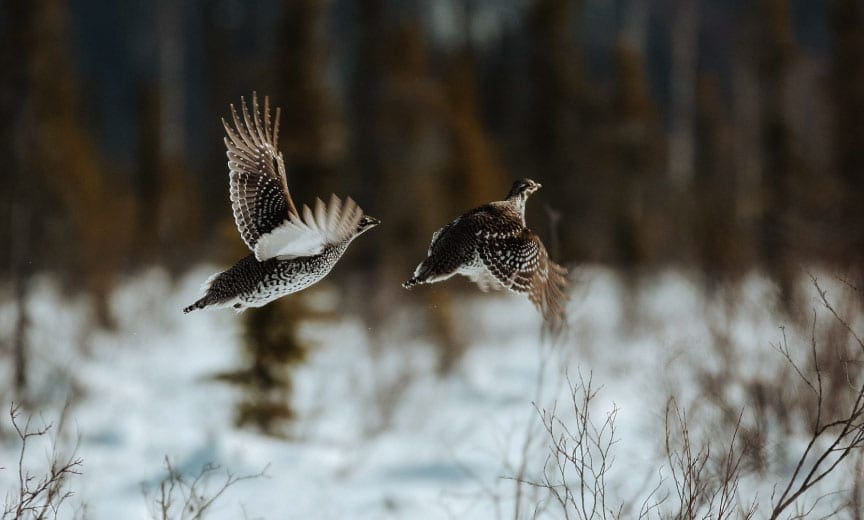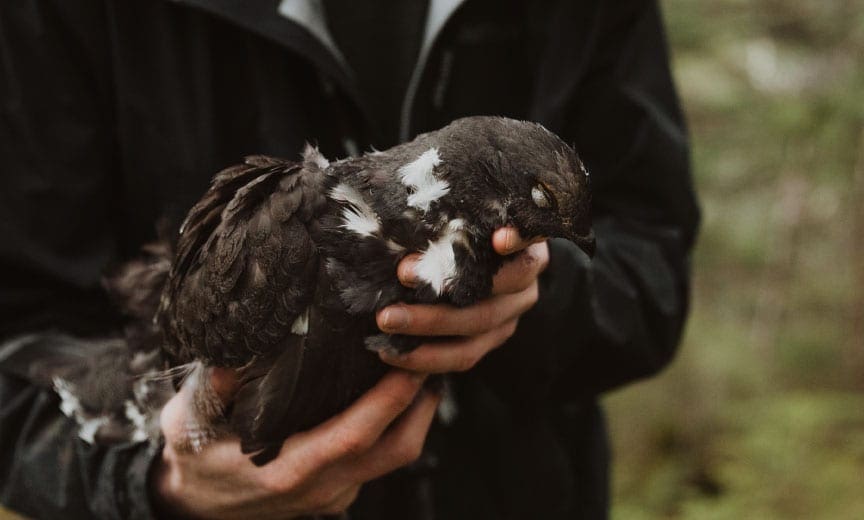Home » Hunting Rules, Licenses, and Seasons » Small Game and Bird Hunting in Alaska, Season Dates, Licenses Fees, and New Rules
Small Game and Bird Hunting in Alaska, Season Dates, Licenses Fees, and New Rules

Scott Johnson is a first generation hunter with a lifelong…
The adventures of small game and bird hunting are ready for the taking on the last frontier
Wilderness flowed in every direction. I took the only road available and parked at its termination along the banks of a winding river. From here, the only navigable path was the river itself, its gravel bars littered with the end of a salmon migration and signs of the bears that come with it. My Labrador and I were here in search of ruffed and spruce grouse, but in Alaska, there’s always more than one layer to the adventure.
Upland hunting in Alaska is an experience like none other. From fly-in hunting, hunting by skis, and even by foot, it is a paradise of upland birds. It is home to seven wild upland bird species, and pursuing them all will take you to vastly diverse and beautiful landscapes all uniquely contained in one state. This richness in diversity also creates a wealth of complications for those who would like to hunt upland birds in the Last Frontier, and deciphering the season dates, huntable areas, daily limits, and everything else that goes into planning a hunt can seem daunting. Let’s break it down so you can have a good starting point should you want to (and you should) come hunt in Alaska.
Game Management Units, season dates, and bag limits
Alaska has twenty-six different game management units, many with their own sub-unit, and the rules can (and do) change between all of them. Some of these units are the size of a small county, while some are as large as a small state. In general, the upland bird season in Alaska opens on August 10 and continues until February 15, February 29, March 31, or April 30, depending upon the GMU.
When it comes to daily bag limits, it’s important to point out that Alaska’s small game regulations have remained largely unchanged since it became a state over sixty years ago, and discretion might be the better part of conservation when you are afield. For grouse species most units have daily bag limits ranging from five to 15 per day, with some zones having an additional regulation that only two birds of the daily limit may be ruffed grouse.
For ptarmigan species the variance is even greater, with limits ranging from five per day to as many as 20, and in some places even 50 per day. The reality of those numbers however is that in most places that are readily accessible, the limits are either five or 10 birds per day.
So with so much variability, where (and when) should you start? Most of your upland bird hunting is going to be done in units 12, 13, 14, and 20, as these zones are the most accessible via Alaska’s limited road system. Alaska’s hunting regulation book is very large, but it is thankfully downloadable from their website. The specifics about season dates and bag limits is on page 141.
Grouse species and seasons
| Grouse Species (Ruffed, Sooty, Spruce, Sharp-tailed) | Dates | Daily/Possession Limits | Notes |
| Units 1-6 | Aug 1 – May 15, 2023 | 5/10 Possession | None |
| Units 7 and 15 | Aug 10 – Mar 31, 2023 | 10/20 Possession | Not more than one per day and two in possession may be ruffed grouse |
| Units 8 and 10 | No open season | — | — |
| Units 9, 17–19, 21–24, and 26 | Aug 10 – Apr 30, 2023 | 15/30 Possession | None |
| Units 11-12, remainder of Unit 20, and Unit 25 | Aug 10 – Mar 31, 2023 | 15/30 Possession | None |
| Units 13, 14A, 14B, and 16 | Aug 10 – Mar 31, 2023 | 15/30 Possession | Not more than two per day and four in possession may be ruffed grouse |
| Unit 14C | Sept 1 – Mar 31, 2023 | 5/10 Possession | Not more than two per day and four in possession may be ruffed grouse |
| Unit 20D | Aug 25 – Mar 31, 2023 | 5/15 Possession | That portion lying west of the east bank of the Johnson River and south of the north bank of the Tanana River. Not more than ten in possession may be either ruffed or sharp-tailed grouse |
Ruffed grouse
Ruffed grouse are most abundant in the interior region of the state around Fairbanks, Delta Junction, and Tok. They can also be found in south-central Alaska as well, which is the area around Anchorage, Wasilla, and Palmer. They take to many of the same habitat types as they would in the lower 48. Look for timber cuts, overgrown wildfire burns, and don’t overlook stream bottoms and river banks. Daily bag limits aside, ruffed grouse in Alaska go through population cycles similar to those in the lower 48, and some years you will definitely have to work harder than others for your opportunities.
READ: Hunting Ruffed Grouse in Alaska
Sharp-tailed grouse
Alaska’s sharp-tailed grouse can be wild and elusive. Like the ruffed grouse they are most abundant in the interior of the state, although they have been occasionally seen in the south-central regions as well. They are known to be drawn to the state’s limited agricultural areas; however, the most accessible places for hunters to find them are freshly overgrown wildfire burns, and on the sparser periphery of ruffed grouse habitat.
READ: Sharptail Hunting Alaska – Finding Fire Birds

Spruce grouse
The spruce grouse is by far the most prevalent of all the grouse species in Alaska. For the most part they can be encountered anywhere there are spruce trees, which includes the interior regions, south-central, the Kenai Peninsula, and south-east areas. If you’re in search of them look for densely wooded spruce forest with some habitat diversity. Be on the lookout for them while hunting for ruffed grouse, as it is common to encounter both on a hunt. If you’re climbing elevation for ptarmigan, don’t be shock to find these from sea level to alpine as well.
READ: Spruce Grouse – the Fool Hen of the Uplands?
Sooty grouse
These birds exist in the south-east area of the state, around the capitol city of Juneau and the surrounding islands. The most notable hunt for these birds exists in the late winter and spring months, when the males are calling during the mating season. Known as sort of a poor man’s turkey hunt, stalking the males and honing in on them in their tree top hideouts is the best way to find them.

Willow, white-tailed, and rock ptarmigan
It’s impossible to think of upland hunting in Alaska without ptarmigan. Rock ptarmigan will hold up in some of the highest elevations. Willow ptarmigan can be found as soon as you break past the tree line, and white tails tend to like the elevation in between. In a simplistic sense, anywhere there’s a mountain you can find ptarmigan. The landscapes they take up are vast, and covering ground is your number one tool to finding them. While hunting grouse in Alaska’s winter snow pack is a fool’s errand, this is when the ptarmigan hunting gets really good. One of the best times to pursue ptarmigan is in February and March, when heavy snowfall has pushed them lower into elevation mountain valleys and passes. Be prepared to put in a lot of miles on snow shoes or skis as the snow pack this time of year is extremely deep.
| Ptarmigan Species (Willow, White-tailed, Rock) | Dates | Daily/Possession Limits | Unit Restrictions |
| Units 1-5, 6A, 6B, and 6C | Aug 1 – May 15, 2023 | 20/40 | Except 6D |
| Unit 15C | Aug 10 – Jan 31, 2023 | 5/10 | The portion north of Kachemak Bay and north of the Fox River |
| Units 6D, 7, 11, 13A, 13C, 13D, 14A, 14B, 15A, 15B, 15C remainder, and 16 | Aug 10 – Mar 31, 2023 | 10/20 | None |
| Units 13B and 13E | Aug 10 – Feb 15, 2023 | 10/20 | None |
| Unit 14C | Aug 10 – Mar 31, 2023 | 10/20 | Except Eklutna Management Area |
| Eklutna Management Area (Unit 14C) | Sep 1 – Mar 31, 2023 | 10/20 | |
| Units 8, 10, 17, 19, 21-22, 24, 25A, 25B, 25D, and Unit 26B | Aug 10 – Apr 30, 2023 | 20/40 | Unit 26B only within the DHCMA and Prudhoe Bay Closed Area |
| Unit 9 | Aug 10 – Feb 28, 2023 | 10/20 | None |
| Units 12, 20, and 25C | Aug 10 – Feb 28, 2023 and Mar 1 – Apr 30, 2023 | 20/40 and 5/10 | None |
| Unit 18 | Aug 10 – May 15, 2020 | 15/30 | None |
| Units 23 and 26 | Aug 10 – June 15, 2023 | 50/100 | Excluding Unit 26B within the DHCMA and Prudhoe Bay Closed Area |
READ: Are Ptarmigan the Quail of the Great North?
Hare hunting in Alaska
An honorable mention for the upland hunter who likes an even more mixed bag is Alaska’s hare and snowshoe hare. Some GMUs have seasons that parallel the upland bird season, while some are open year round. Check the regulations for the unit you plan to hunt and keep an eye out for them!
| Hare Species (Snowshoe and Alaska) | Dates | Daily/Possession Limits | Notes |
| Units 1–5 and 14C | Sep 1 – Apr 30, 2023 | 5 Per Day | |
| Units 6–8, 10-13, 14B, 15-16, 19-21, 24-26: | No Closed Season | No Limit | |
| Unit 9 and 17 (Snowshoe Hare) | No Closed Season | No Limit | |
| Unit 9 (Alaska Hare) | Nov 1 – Jan 31, 2023 | 1/4 | |
| Unit 14A | No Closed Season | 5 Per Day | |
| Units 18, 22, 23 (Snowshoe Hare) | No Closed Season | No Limit | |
| Units 18, 22, 23 (Alaska Hare) | Aug 1 – May 31, 2023 | 2/6 |
Other small game seasons
| Small Game Species | Dates | Daily/Possession Limits | Unit Restrictions |
| Squirrel (Red, Ground, and Flying) | No Closed Season | No Limit | Special area restrictions in Unit 14C |
| Crow (Units 1–9 and 15) | Mar 1 – Apr 15, 2022 and Sep 1 – Nov 17, 2022 | 5 Per Day | See Regulations |
| Crow (Units 10–14 and 16–26) | No season | — | — |
Hunting license fees in Alaska and hunters safety courses
Alaska, for the vastness of its offerings, has a very simple licensing structure when it comes to small game hunting. A basic hunting license is all that is required.
| LICENSE* | Resident | Non-resident | Non-resident Alien |
| Annual Hunting | $45.00 | $160.00 | $630.00 |
| Small Game Only | — | $60.00 | — |
| Military Annual | — | $45.00 | — |
Hunters safety course is still required for anyone who is born after January 1, 1986. The currently offer two versions of hunters safety. First, an instructor-led in person course with two parts including an 8 hour field day. It requires a $10.00 fee for the hunter education packet. The second option, and online option, still requires a 4 hour field day and a $19.95 fee.
Safety in hunting Alaska
Every upland hunting trip in Alaska is a backcountry adventure, and you need to plan accordingly. Basic wilderness navigation skills are mandatory, and always carry some amount of survival and first aid supplies. Depending upon location and time of year, the road you drove in could be the only one in the entire region, and help could literally be a week away. Bears are an ever-present risk factor as well. If hunting an area where bear encounters are a concern (which is most of them), I highly recommend running bells on your dogs and/or yourself so you don’t surprise anyone. Bear spray is also a mandatory accessory, and some hunters choose to carry a sidearm as well. When hunting brushy, overgrown grassy areas, especially those near rivers that get salmon runs, be alert and let any bears you see have their space. If you plan on hunting the winter and spring ptarmigan seasons, you need to educate yourself on avalanches as well. An ounce of prevention is worth a million pounds of cure when it comes to avalanches. Alaska Avalanche School (alaskaavalanche.org) is a great resource for this; check out their website for class information and stay safe.
Project Upland always recommends wearing blaze orange while hunting. Alaska does not require blaze orange to be worn while hunting, but it is recommended to increase your safety.
It takes a lot to bird hunt in Alaska. Alaska is great in size and opportunity, and the upland hunting in the 49th is amazing. Thankfully, the Alaska Department of Fish and Game has a lot of resources to help you plan your hunt, species profiles, and interactive Game Management Unit map. Check out their website, specifically their small game hunting information section. I also encourage you to take part in their wing submission program to help the state’s biologists study bird populations across the state. Rick Merizon is the state’s small game biologist and is a fantastic resource as well (richard.merizon@alaska.gov) for any questions you may have.
*The bird hunting season dates, game bird species available, and other information is subject to change. The article may not reflect this. Please visit the Alaska Department of Fish and Game for the most up-to-date information on hunting in Alaska
Scott Johnson is a first generation hunter with a lifelong passion for the outdoors. Originally a fisherman and grouse hunter from Norther Minnesota, he spends his seasons traveling across the country in search of upland birds and waterfowl with his beloved labrador Watson. He hunts and lives out of a converted van that he purpose built for his pursuits, and can be found anywhere from the Midwest to the deserts of Arizona, and as far north as Alaska.




